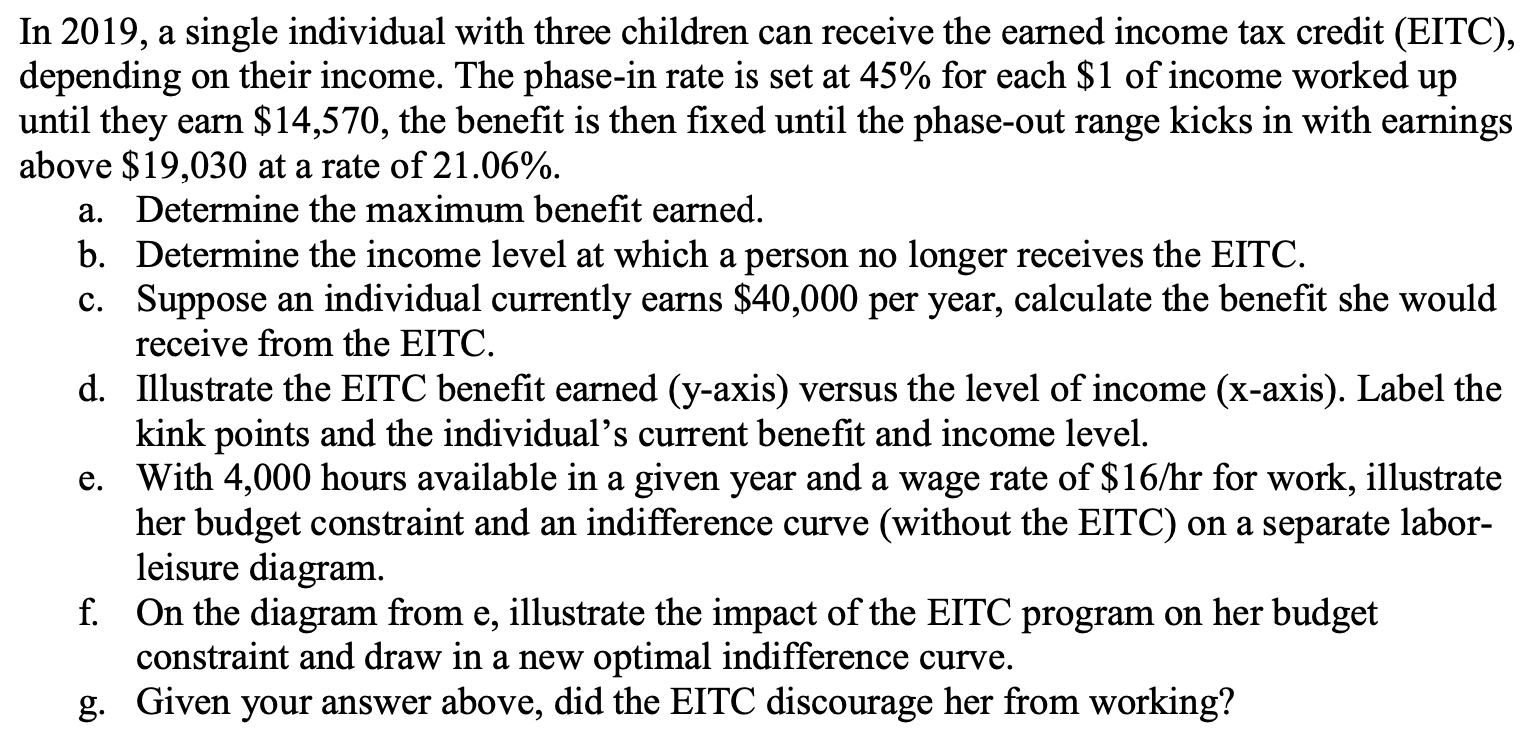In 2019, a single individual with three children can receive the earned income tax credit (EITC), depending on their income. The phase-in rate is set at 45% for each $1 of income worked up until they earn $14,570, the benefit is then fixed until the phase-out range kicks in with earnings above $19,030 at a rate of 21.06%. a. Determine the maximum benefit earned. b. Determine the income level at which a person no longer receives the EITC. c. Suppose an individual currently earns $40,000 per year, calculate the benefit she would receive from the EITC. d. Illustrate the EITC benefit earned (y-axis) versus the level of income (x-axis). Label the kink points and the individual's current benefit and income level. e. With 4,000 hours available in a given year and a wage rate of $16/hr for work, illustrate her budget constraint and an indifference curve (without the EITC) on a separate labor- leisure diagram. f. On the diagram from e, illustrate the impact of the EITC program on her budget constraint and draw in a new optimal indifference curve. g. Given your answer above, did the EITC discourage her from working?
In 2019, a single individual with three children can receive the earned income tax credit (EITC), depending on their income. The phase-in rate is set at 45% for each $1 of income worked up until they earn $14,570, the benefit is then fixed until the phase-out range kicks in with earnings above $19,030 at a rate of 21.06%. a. Determine the maximum benefit earned. b. Determine the income level at which a person no longer receives the EITC. c. Suppose an individual currently earns $40,000 per year, calculate the benefit she would receive from the EITC. d. Illustrate the EITC benefit earned (y-axis) versus the level of income (x-axis). Label the kink points and the individual's current benefit and income level. e. With 4,000 hours available in a given year and a wage rate of $16/hr for work, illustrate her budget constraint and an indifference curve (without the EITC) on a separate labor- leisure diagram. f. On the diagram from e, illustrate the impact of the EITC program on her budget constraint and draw in a new optimal indifference curve. g. Given your answer above, did the EITC discourage her from working?
Managerial Economics: Applications, Strategies and Tactics (MindTap Course List)
14th Edition
ISBN:9781305506381
Author:James R. McGuigan, R. Charles Moyer, Frederick H.deB. Harris
Publisher:James R. McGuigan, R. Charles Moyer, Frederick H.deB. Harris
Chapter17: Long-term Investment Analysis
Section: Chapter Questions
Problem 9E
Related questions
Question

Transcribed Image Text:In 2019, a single individual with three children can receive the earned income tax credit (EITC),
depending on their income. The phase-in rate is set at 45% for each $1 of income worked up
until they earn $14,570, the benefit is then fixed until the phase-out range kicks in with earnings
above $19,030 at a rate of 21.06%.
a. Determine the maximum benefit earned.
b. Determine the income level at which a person no longer receives the EITC.
c. Suppose an individual currently earns $40,000 per year, calculate the benefit she would
receive from the EITC.
d. Illustrate the EITC benefit earned (y-axis) versus the level of income (x-axis). Label the
kink points and the individual's current benefit and income level.
e. With 4,000 hours available in a given year and a wage rate of $16/hr for work, illustrate
her budget constraint and an indifference curve (without the EITC) on a separate labor-
leisure diagram.
f. On the diagram from e, illustrate the impact of the EITC program on her budget
constraint and draw in a new optimal indifference curve.
g. Given your answer above, did the EITC discourage her from working?
Expert Solution
This question has been solved!
Explore an expertly crafted, step-by-step solution for a thorough understanding of key concepts.
Step by step
Solved in 3 steps

Recommended textbooks for you

Managerial Economics: Applications, Strategies an…
Economics
ISBN:
9781305506381
Author:
James R. McGuigan, R. Charles Moyer, Frederick H.deB. Harris
Publisher:
Cengage Learning

Managerial Economics: Applications, Strategies an…
Economics
ISBN:
9781305506381
Author:
James R. McGuigan, R. Charles Moyer, Frederick H.deB. Harris
Publisher:
Cengage Learning